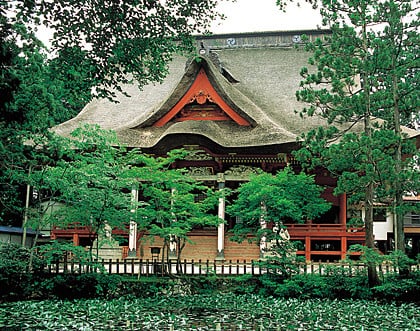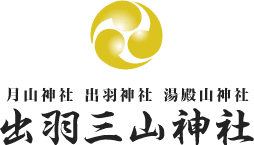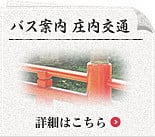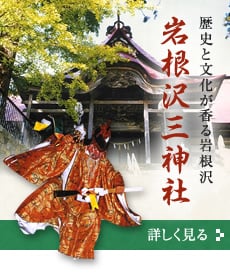Hagurosan
Hagurosan

Hagurosan Mountain
Hagurosan Mountain is a gently sloping mountain with an elevation of 414 meters, and lies between the Haraigawa River to the west and the Tachiyazawagawa River to the east.
Among the three Dewa mountains, the Shrines on Gassan and Yudono are far removed from civilization, and difficult to make pilgrimages to in winter due to the deep snows.
Because of this, at the summit of Hagurosan Mountain, Dewa Shrine was built as a great village shrine for Gassan and Yudonosan Mountains. This shrine has a magnificent temple to the gods of the three mountains and serves as the main shrine of the area.
From long ago, the main shrine flourished as a focal point for the "Haguro Shugendo" type of asceticism, and pilgrims still visit the area year-round.
Among the three Dewa mountains, the Shrines on Gassan and Yudono are far removed from civilization, and difficult to make pilgrimages to in winter due to the deep snows.
Because of this, at the summit of Hagurosan Mountain, Dewa Shrine was built as a great village shrine for Gassan and Yudonosan Mountains. This shrine has a magnificent temple to the gods of the three mountains and serves as the main shrine of the area.
From long ago, the main shrine flourished as a focal point for the "Haguro Shugendo" type of asceticism, and pilgrims still visit the area year-round.
Past the Suishinmon Gate are the precincts of the Dewa Sanzan Shrine. The precincts of the shrine extend over Gassan Mountain and continue all the way to far-off Yudonosan Mountain. The gate was originally dedicated as a Buddhist "Niomon" gate but during the Meiji separation of Shinto and Buddhist belief systems it was rededicated as a Shinto gate.
Leading down the Mamako Hill from the Suishinmon Gate is a holy bridge crossing the Haraigawa River. In the past, pilgrims to the three mountains would submerge themselves and perform ablutions in the Haraigawa River before climbing the mountain to complete their pilgrimage. The red lacquered bridge is provided a beautiful backdrop by the Suga Waterfall and rugged cliffs, making for a stunning scene.
Both sides of the two kilometer pilgrimage road to the summit are thick with ancient and seemingly melancholy cedar trees, ranging from three to six hundred years old. These trees have a dark and mysterious appearance even in full sunlight. The long stone staircase has in total 2,446 steps, and along the way are the "ichi-no-zaka", "ni-no-zaka" and "san-no-zaka" areas of steep climbing.
The left hand side of the entrance of the ichi-no-zaka area is surrounded by cedars, in which stands the five-story pagoda. Made entirely of wood, with a thin wooden-shingled roof and three space, five story construction, it is a graceful structure, as well as being the oldest of these magnificent pagodas in the Tohoku region (1966 National Treasure Designation). It is said that the construction was at the direction of Masakado Taira, and the rebuilding was directed by Emperor Chokei's footman Masauji Futo, the lord of Shonai and governor of Haguro.
Just beyond the "ni-no-zaka" area is a flat stone paved road that continues for some ways. Turning left at the entrance to the "san-no-zaka" area and continuing down the path leads to the Southern Valley. This road is notable for its old pines and cedars clinging to the cliff sides. The remains of the detached temple that haiku poet Basho Matsuo and his apprentice Sora Kawai stopped at during their pilgrimage to the north can be seen here. All that is left now is a portion of the stone foundation, but one can feel the shadow of the calm and peaceful garden that was once fed by the nearby pond.
Just past the three steep areas is the "Saikan" structure. It is the only pilgrim's lodging still extant on the mountain, and still operates as such for pilgrims to the three mountains. Lodgers can experience the monks' unique cuisine and get a feeling for what it was like to make a pilgrimage to the mountains in days past.
Past the red gate at the summit towards the left is the worship hall to the three gods. The shrine is the largest thatched-roof construction shrine in Japan, and is a splendid red-lacquered structure. The altar area is separated by a "mitomae" gateway and enshrines the deities of Gassan, Hagurosan and Yudonosan. There have been many fires at this temple, and the current shrine building is a reconstruction dating to 1818.
The pond in front of the shrine building is for washing one's hands, and has been revered as a holy pond since ancient times for not changing character in any season. It is called the "Mirror Pond" for the many copper mirrors that people have given it as offerings.
On the east side of the pond there is a gabled thatched-roof structure, the "kanezakura", or cherry blossom bell. This is the second oldest structure on the three mountains after the five-story pagoda. The inscription on the bell dates it to 1275, and following those at the Todaiji and Kongobuji temples it is the oldest and largest, and is registered as a National Important Cultural Asset.
The three mountains of Dewa have for many centuries been revered as places where the spirits of the ancestors find respite, and to this day memorial services to the dead are held. These ceremonies are held at the Raisenden, a five-room, laminate construction shrine building with eaves beneath the zigzag stitched gables. The Raisenden was rebuilt in 1983.
Within the mountain precincts there are many historical cultural assets which recall the affluence of elder days.
Leading down the Mamako Hill from the Suishinmon Gate is a holy bridge crossing the Haraigawa River. In the past, pilgrims to the three mountains would submerge themselves and perform ablutions in the Haraigawa River before climbing the mountain to complete their pilgrimage. The red lacquered bridge is provided a beautiful backdrop by the Suga Waterfall and rugged cliffs, making for a stunning scene.
Both sides of the two kilometer pilgrimage road to the summit are thick with ancient and seemingly melancholy cedar trees, ranging from three to six hundred years old. These trees have a dark and mysterious appearance even in full sunlight. The long stone staircase has in total 2,446 steps, and along the way are the "ichi-no-zaka", "ni-no-zaka" and "san-no-zaka" areas of steep climbing.
The left hand side of the entrance of the ichi-no-zaka area is surrounded by cedars, in which stands the five-story pagoda. Made entirely of wood, with a thin wooden-shingled roof and three space, five story construction, it is a graceful structure, as well as being the oldest of these magnificent pagodas in the Tohoku region (1966 National Treasure Designation). It is said that the construction was at the direction of Masakado Taira, and the rebuilding was directed by Emperor Chokei's footman Masauji Futo, the lord of Shonai and governor of Haguro.
Just beyond the "ni-no-zaka" area is a flat stone paved road that continues for some ways. Turning left at the entrance to the "san-no-zaka" area and continuing down the path leads to the Southern Valley. This road is notable for its old pines and cedars clinging to the cliff sides. The remains of the detached temple that haiku poet Basho Matsuo and his apprentice Sora Kawai stopped at during their pilgrimage to the north can be seen here. All that is left now is a portion of the stone foundation, but one can feel the shadow of the calm and peaceful garden that was once fed by the nearby pond.
Just past the three steep areas is the "Saikan" structure. It is the only pilgrim's lodging still extant on the mountain, and still operates as such for pilgrims to the three mountains. Lodgers can experience the monks' unique cuisine and get a feeling for what it was like to make a pilgrimage to the mountains in days past.
Past the red gate at the summit towards the left is the worship hall to the three gods. The shrine is the largest thatched-roof construction shrine in Japan, and is a splendid red-lacquered structure. The altar area is separated by a "mitomae" gateway and enshrines the deities of Gassan, Hagurosan and Yudonosan. There have been many fires at this temple, and the current shrine building is a reconstruction dating to 1818.
The pond in front of the shrine building is for washing one's hands, and has been revered as a holy pond since ancient times for not changing character in any season. It is called the "Mirror Pond" for the many copper mirrors that people have given it as offerings.
On the east side of the pond there is a gabled thatched-roof structure, the "kanezakura", or cherry blossom bell. This is the second oldest structure on the three mountains after the five-story pagoda. The inscription on the bell dates it to 1275, and following those at the Todaiji and Kongobuji temples it is the oldest and largest, and is registered as a National Important Cultural Asset.
The three mountains of Dewa have for many centuries been revered as places where the spirits of the ancestors find respite, and to this day memorial services to the dead are held. These ceremonies are held at the Raisenden, a five-room, laminate construction shrine building with eaves beneath the zigzag stitched gables. The Raisenden was rebuilt in 1983.
Within the mountain precincts there are many historical cultural assets which recall the affluence of elder days.









